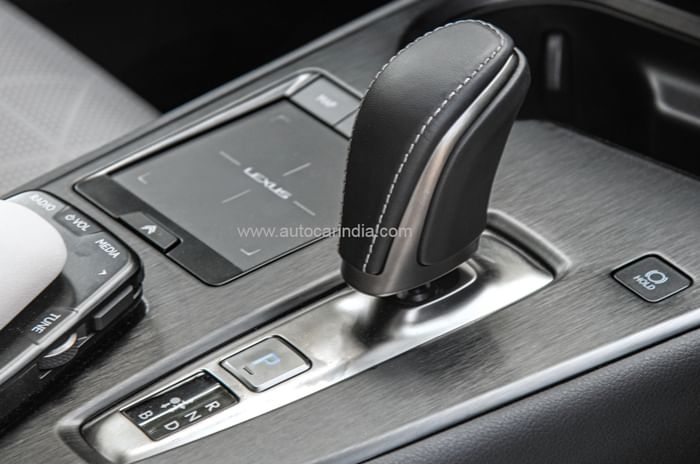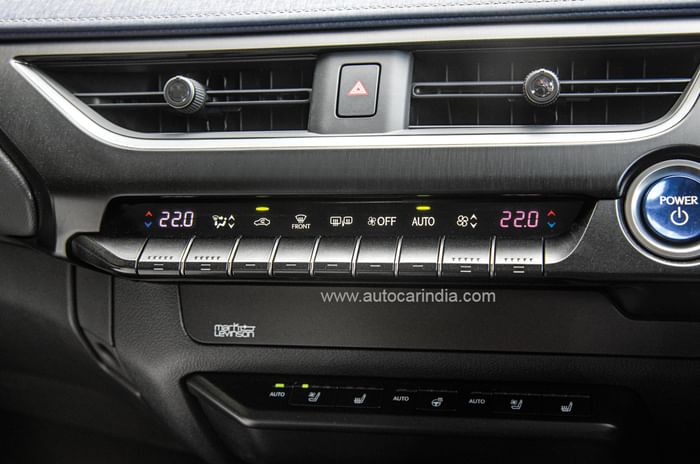Here’s something very different: a pair of compact, luxury, electrified crossovers. Less than 4.5-metres long, radically designed and likely to be available in future powered by an EV powertrain, a strong hybrid drive or both, this pair is nothing if not different. Now, those of you familiar with the automotive flora and fauna of the sub-continent may ask what these compact beasts are doing in an environment that, on the face of it, appears so ‘alien’... one where size and perceived value walk hand in hand. And justifiably so. The answer, however, is simple; Lexus wants to gauge the response the UX is likely to get in our market. It wants to see if Indian luxury car buyers have evolved sufficiently to allow the UX some measure of success here, and it is also asking dealer partners what they think of the UX’s prospects here. So, what’s it like?

Sharp as a tack
Compact, to begin with, especially in the flesh, and that’s despite being considerably longer at 4,495mm than the 4,300mm Creta. This, in part, is down to the profile. While the nose is long and large, the cabin is extremely compact and sporty. And then what makes it look even smaller is that it isn’t fleshed out or tall like a typical SUV, but sinewy and muscular.

High-quality satin finish on piano key-like buttons impressive.
The sharp styling may not be to everyone’s taste, but it gets your attention. Done using bold confident strokes, like the ones used in Japanese calligraphy, the UX is full of razor-like cuts and creases. Details you can’t ignore include the large spindle-shaped grille up front, dagger-shaped headlights, and then to make it look even more fierce, it even gets what look like stylised chrome fangs. Check them out. I particularly like the kink in the wheel arches, done in homage (I guess) to the Countach, and around the rear the linked tail-lights protrude in a particularly interesting manner. The pay-off of the low slung profile is that the UX is unlikely to have a high centre of gravity and that should help make it sharp and fun from behind the wheel.
Mark Levinson audio system sound quality transcends its spec.
The car is also based on the midsized TNGA platform, which will help when it comes to assembling it locally in India later. And to make it ride and handle better than a regular Toyota, Lexus’ engineers have increased the rigidity of the structure. That’s not it; to keep weight down the UX also uses aluminum doors, it has an alloy bonnet and then, like the XUV700, it even uses a plastic composite hatch at the rear.
Hooded instrument panel with drive mode shortcut is a cool touch.
Cool, classy, comfy for two
Open the door and the luxury vibe is clearly there. The layered dash, finished predominantly in black, works well, and then, the surfaces have a rich texture and expensive feel. Particularly appealing is the soft top of the dash, finished in a very techy matt black material with contrast stitching, it feels very upmarket. Then the long piano key-like buttons have a superb satin finish and click satisfyingly when engaged and the thick-rimmed steering and hooded instrument panel remind you of Lexus’ LFA supercar. Even love the slick manner in which the gear selector and vents function.
In fact, the closer you look, the more impressed you get with the quality on the inside.
Yes, some plastics lower down are distinctly ordinary and look more Toyota than Lexus and the fact that there’s no touchscreen, only a fiddly trackpad, rankles. But then, there are also plenty of interesting bits. I particularly like how the drive modes can be adjusted via rollers on either side of the instrument cluster, the analogue clock gives the cabin a classy feel and Lexus’ Mark Levinson audio systems transcend mere spec and sounds just fantastic, a big bonus.
Rear seat is not spacious, battery reduces legroom, not ideal for intercity travel.
It’s not very large on the inside. Most of that is down to the tight fitting glasshouse and roof. There is sufficient width to keep front seat occupants comfortable and the beautifully stylised bucket seats are sporty and provide excellent support. And the seats are cooled and heated.
Space in the rear, however, is tight. This is especially true on the EV where the thick battery placed under the floor also ‘protrudes’ into the cabin. This means you sit with your knees slightly raised and apart from legroom being poor, those over six feet will also brush their head on the roof. Elsewhere, the tall seats and small windows mean visibility isn’t great either at the rear. The thick A pillars and large door mirrors often hide bikers behind them when you are at the wheel; and when you have to reverse its best to make use of the sharp and clear 360-degree camera... the slot-like rear windscreen is tiny. The boot isn’t very practical either. This one has just around 300 litres and is shallow, so it’s not much better than a hatchback.
Zippy, nippy, kinda trippy
I first climb behind the wheel of the more familiar of the two, the Hybrid. The 250h gets a 152hp engine, a 109hp permanent magnet synchronous electric motor and a combined system power of 184hp. Putting it all together is a CVT transmission, which makes the engine sound strained if you go flat on the throttle. The hybrid system, however, is actually reasonably accelerative, with 0-100kph dispatched in around 8.5 seconds. And what’s nice is Toyota’s CVT works smoothly in steps, if you don’t go past the detent on the accelerator pedal. In fact, at medium speeds, this powertrain combo is pretty refined, smooth and pleasing to pedal around in a relaxed manner. In addition, you can select EV mode for short distances, so in a way this Hybrid is the perfect one size fits all solution.
But it’s the 204hp EV, the blue one, that feels more enjoyable, both on the ICAT track in Manesar and out on the open road. For one, all the drive modes are imminently usable. It responds well to the first tap on the throttle even in ECO, power is delivered in a smooth manner, and then, even when you flatten the throttle, it doesn’t taper off artificially. ‘Normal’ mode is even nicer and more responsive, but the real fun mode is ‘Sport’ and here that initial EV kick just gets you grinning. In fact, go flat on the throttle in Sport and the UX relies quite heavily on its traction control system. The rate of acceleration does smoothen out a bit after the first hit of power, but acceleration still remains high and it’s loads of fun... 0-100kph coming up in a claimed 7.5 seconds. You can also use the paddles behind the steering wheel to increase regen, but levels aren’t strong enough for ‘one-pedal driving’.
The UX EV also has plenty of range. The 54.3kWh battery has a WLTP range of 300-315km and on a 11kW charger took six hours to charge to well over 95 percent. DC charging is also possible with a 50kW charger taking it to 80 percent in under an hour.
The UX has a supple and comfortable suspension. This is especially true on the hybrid where the suspension is absorbent, there is sufficient travel for larger undulations and the ride is pretty flat. You can feel the extra weight of the battery in the electric version, and this causes some small amount of movement from the body, especially over large bumps. Also, over large speed breakers you need to be careful of the big, low slung battery; it will make contact with large speed breakers if you are not careful.
Hatch at the rear isn’t made of metal, but it’s tough to tell.
What makes it fun on the open road is that the UX has a quick and precise steering, good grip and a sharp turn in. It isn’t ‘sporty’ in a traditional sense. The steering lacks feel, the brakes are initially a bit mushy, and although it changes direction keenly enough, it does lean and roll in tighter corners.
The electrified choice
Will the Lexus UX make it to Indian shores? A lot depends on the kind of reaction the luxury car buying public has to it. On the one hand, the UX is clearly a departure from the typical entry luxury SUV template. It isn’t as practical, the sharp looks make it stand out and then what makes this pair unique is that there currently is no hybrid or electric in this class yet.
While Lexus is still testing both versions for India and working out a business case, expect the Hybrid UX 250h to come at around Rs 50 lakh once it is assembled here, with the all-electric 300e likely to cost between Rs 55 lakh or 60 lakh, depending on local taxes and global prices at the time. Even at this price, those looking for a self-driven, fun electric that has loads of individual appeal could find this car appealing. We certainly did.
Also see:
Lexus’ first bespoke EV will be an SUV, will arrive next year




